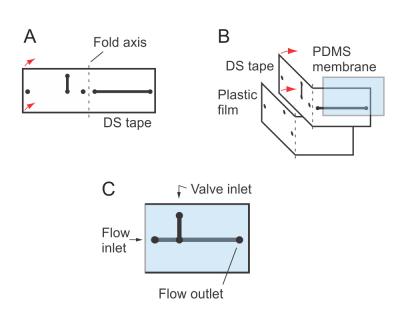NIST's simple microfluidic devices now have valves

Double-sided tape is cut with channels and ports that will align when folded (A). The polymer membrane that supplies the valve function for the microfluidic device is sandwiched between (B). The completed apparatus (C) has ports for fluid flow into and out of the device, as well as a valve inlet for air. Air pressure pushes the membrane into the flow channel, blocking fluid movement. Credit: Gregory A. Cooksey/National Institute of Standards and Technology
Traditionally, microfluidic devices—tiny gadgets with fluid-carrying channels used in medical diagnostics, DNA forensics and “lab-on-a-chip” chemical analyzers—have been fabricated like microchips using photolithography.
A desired pattern of micrometer-sized channels and ports is created on top of a silicon substrate, which can then be replicated many times by techniques such as molding or embossing. However, the process requires specialized cleanroom equipment and can take several days to complete.
If valves are needed in the system, they traditionally have been made from silicones. Unfortunately, silicones are not the best materials to use with particular laboratory assays or for manufacturing lab-on-a-chip structures.
NIST researchers have spent the past few years developing and refining a method for making microfluidic devices using plastic films and double-sided tape that produces a functional apparatus in hours rather than days and requires only simple tools to create channels and ports.
The NIST designs allow for folding the films to make multilayer or three-dimensional structures, can be used to make devices with multiple functions, and cost a fraction of traditional fabrication techniques.
But until now, there has not been a practical way to incorporate valves for dynamic control of fluid flow in these devices. In a new paper in the journal Lab on a Chip,* NIST bioengineer Gregory Cooksey and research engineer Javier Atencia describe the first-ever technique for building pneumatic microvalves into 2-D and 3-D microfluidic devices made with plastic films and tape.
Like previous NIST systems,** the new valved microfluidic device is built in layers. Narrow slits and holes are cut into pieces of double-sided tape that become tiny channels and ports when the tape is folded on itself.
The microvalve is made by sandwiching a flexible membrane between two channels that intersect, one on top of the other. Applying air pressure to the top channel pushes the membrane down like a diaphragm valve, closing the lower channel.
Cooksey and Atencia have demonstrated that their novel microvalve also can work with more complex configurations of the NIST microfluidic system. These include devices with different designs for performing different tasks simultaneously, multiple layers with different flow rates, and single units with multiple “microfluidic walls” that can fold together to form a 3-D shape.
In one trial with a cubed-shaped device, the researchers filled it with agar and grew nematodes (Caenorhabditis elegans) inside. Using the microchannels, ports and valves built into the cube's walls, they injected chemicals at controlled concentrations that either attracted or repelled the worms. This showed that the cube was a unique setup for studying a living organism's response to chemical stimuli within a closed environment.
*G.A. Cooksey and J. Atencia. Pneumatic valves in folded 2-D and 3-D fluidic devices made from plastic films and tapes. Lab on a Chip (March 2014). DOI:10.1039/C4LC00173G
**See NIST Tech Beat issue of Feb. 7, 2012, “New NIST 'Cell Assay on a Chip': Solid Results from Simple Means” at http://www.nist.gov/mml/bbd/fluidics-020712.cfm.
Media Contact
All latest news from the category: Life Sciences and Chemistry
Articles and reports from the Life Sciences and chemistry area deal with applied and basic research into modern biology, chemistry and human medicine.
Valuable information can be found on a range of life sciences fields including bacteriology, biochemistry, bionics, bioinformatics, biophysics, biotechnology, genetics, geobotany, human biology, marine biology, microbiology, molecular biology, cellular biology, zoology, bioinorganic chemistry, microchemistry and environmental chemistry.
Newest articles

Properties of new materials for microchips
… can now be measured well. Reseachers of Delft University of Technology demonstrated measuring performance properties of ultrathin silicon membranes. Making ever smaller and more powerful chips requires new ultrathin…

Floating solar’s potential
… to support sustainable development by addressing climate, water, and energy goals holistically. A new study published this week in Nature Energy raises the potential for floating solar photovoltaics (FPV)…

Skyrmions move at record speeds
… a step towards the computing of the future. An international research team led by scientists from the CNRS1 has discovered that the magnetic nanobubbles2 known as skyrmions can be…





















